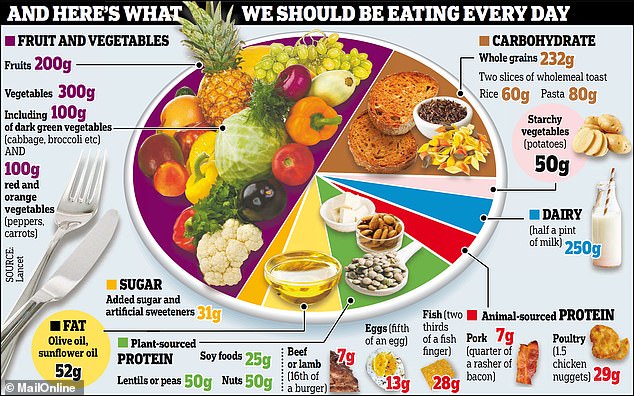Summer holidays are often the perfect opportunity to fire up the barbecue.
But instead of reaching for sausages and burgers, scientists at the University of Birmingham say we should be reaching for vegetable kebabs instead.
A new study claims that adopting a “planetary health diet” – consisting primarily of fruits, vegetables, grains, plant-based proteins and unsaturated oils – could help save the planet.
Unfortunately for meat lovers, this diet only includes very small amounts of dairy and “animal proteins,” such as eggs, fish, and meat.
Researchers estimate that if everyone in the world adopted a planet-healthy diet, food-related greenhouse gas emissions would decline by 17 percent.
Researchers say adopting a “planetary health diet” consisting primarily of fruits, vegetables, grains, plant-based proteins and unsaturated oils could help save the planet.

Unlike veganism or vegetarianism, the planetary health diet greatly reduces meat consumption rather than eliminating it completely.
Unlike veganism or vegetarianism, the planetary health diet greatly reduces meat consumption rather than eliminating it completely.
Experts suggest limiting “animal protein” (meat and fish) intake to 3.6 percent of our total food consumption.
Meanwhile, dairy intake is the same (3.6 percent), while the rest of the diet is made up of whole grains (17 percent), plant-based proteins (such as tofu and nuts, 11.7 percent), unsaturated vegetable oils (9.5 percent), added sugars (3 percent) and starchy vegetables (1.5 percent).
“Current annual global food emissions would be reduced by 17 percent with global adoption of the planetary health diet,” the researchers say in their paper.
‘(This would be attributed) mainly to the shift from red meat to legumes and nuts as the main sources of protein.’
For their study, the researchers analyzed data on household food consumption and food-related greenhouse gas emissions.
According to the results, 56.9 percent of the world’s population currently suffers from “overconsumption” – that is, they eat too much meat and dairy products.
If this majority adopted the planetary healthy diet, 32.4 percent of food-related greenhouse gas emissions would be eliminated.
Overall, China (contributing 13.5 percent of emissions) and India (8.9 percent) are the largest contributors to global food emissions, because they are the most populous countries in the world.

Experts recommend limiting intake of “animal protein” (meat and fish) to 3.6 percent of our total food consumption. Dairy product intake is the same (3.6 percent), while the rest of the diet is made up of whole grains (17 percent), plant proteins (11.7 percent), unsaturated vegetable oils (9.5 percent), added sugars (3 percent) and starchy vegetables (1.5 percent).

Meat-rich diets are fueled by intensive livestock farming, which destroys habitats and generates greenhouse gases (file photo)
Scientists have long been vocal about the enormous carbon footprint left by humanity’s love of meat, fish and dairy products, especially beef.
Livestock farming contributes to global warming due to methane, nitrous oxide and carbon emissions from livestock and their supply chains.
What’s more, clearing deforestation to make room for cattle ranching reduces the number of trees that absorb carbon dioxide.
“The food system is responsible for about one-third of global greenhouse gas emissions of anthropogenic origin,” the authors of the study warn.
“Climate goals become unattainable without efforts to reduce food-related emissions.”
According to the team, the United States, Australia and Western Europe (including the United Kingdom) are currently the largest consumers of meat in the world.
Meanwhile, countries such as India, Indonesia and other parts of Southeast Asia are among the least avid meat eaters, opting instead for grains or dairy products.

The United States, Australia and Western Europe (including the United Kingdom) are the world’s heaviest meat eaters. This chart shows the percentage of foods that make up the average diet in these places (meat in green).

India, Indonesia and other parts of Southeast Asia are among the least avid meat eaters, researchers reveal
Not surprisingly, poorer eastern countries focus more on consuming grains such as rice and barley than developed countries, which eat a lot of meat.
Therefore, “not everyone” in the world contributes equally to food-related greenhouse gas emissions, the researchers note.
The team acknowledges that many poorer countries cannot afford to make a widespread shift away from meat, so developed countries may bear the greatest responsibility going forward.
“We should try to reduce overconsumption of emissions-intensive products in rich countries, such as beef in Australia and the US, especially among wealthy consumer groups who consume excessive amounts,” said Dr Yuli Shan.
“This would help achieve significant health and climate benefits.”

This map shows food-related greenhouse gas emissions worldwide in 2019. Overall, China (contributing 13.5 percent of emissions) and India (8.9 percent) are the largest contributors to global food emissions, because they are the world’s most populous countries.
Introducing incentives, such as traffic-light emissions labels, and expanding the availability of lower-emission products, such as vegetarian foods, can encourage consumers to make dietary changes.
Reducing greenhouse gases is crucial to preventing a climate disaster – although the food industry is, of course, only one of many sources of emissions.
Over time, the planet will become too hot due to the greenhouse effect, leading to widespread heat exhaustion and death, flooding in coastal cities due to ice buildup at the poles and food shortages, they believe.
The study was published today in the journal Nature Climate Change.

